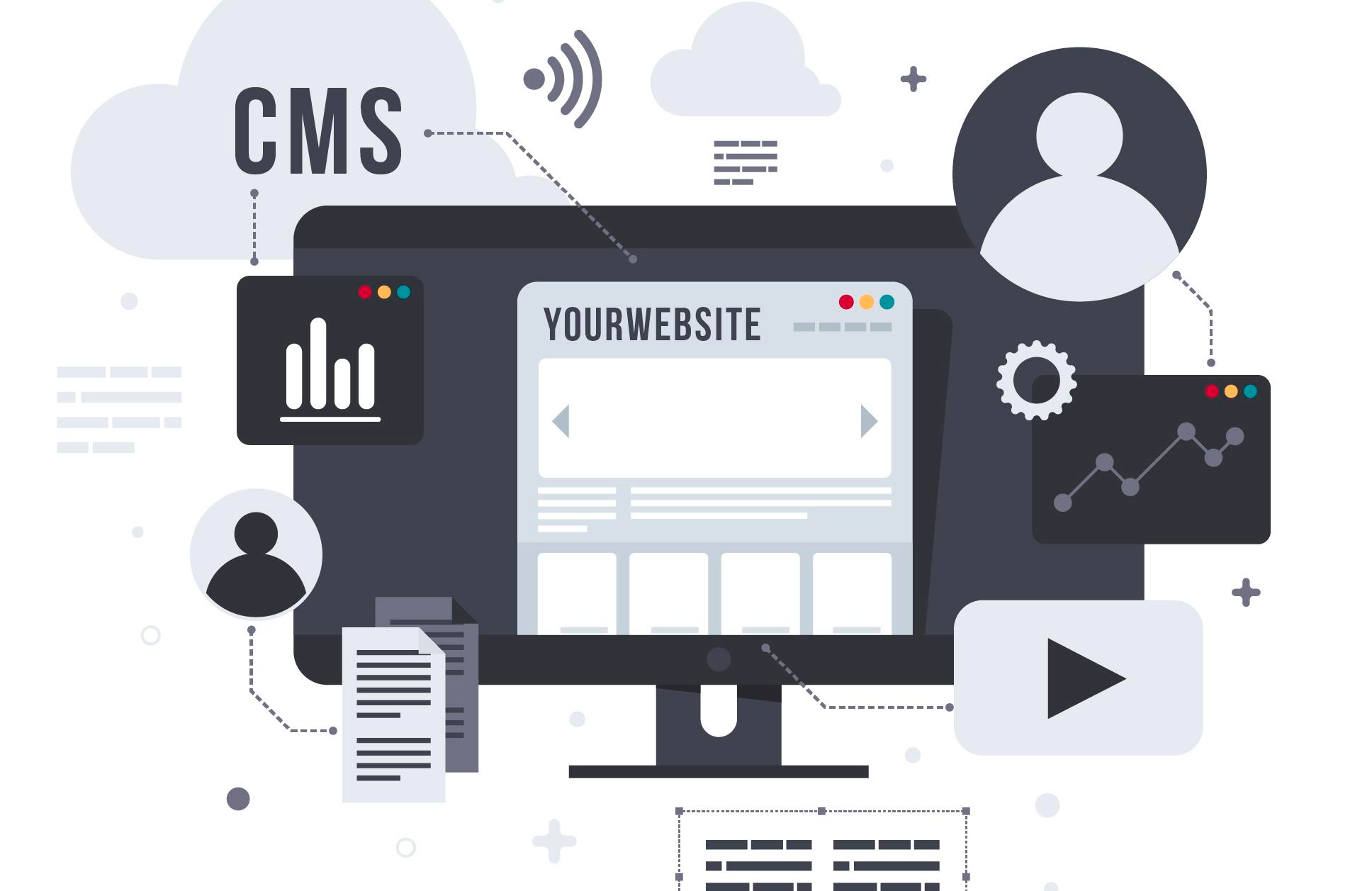


Are you wondering what CMS platform to use for building your website?
A CMS (Content Management System) platform lets you easily create a website without understanding any code (at least for most of them). There are lots of CMS options available, which means you might struggle to choose the best CMS for your needs.
In this article, we’ll be explaining why it’s so important to choose the right CMS platform for your website. We’ll also share our top picks for the best CMS platforms along with a comparison.
A CMS platform (content management system platform) is a piece of software that allows you to easily manage content and create a website.
Normally, web pages are written in HTML, JavaScript, and CSS programming languages. If you were to build a website without a CMS platform, then you would need to learn these languages and write a lot of code.
CMS platforms solve this problem by allowing you to make a website without writing code or learning programming.
Unless of course, you’re looking for a developer-friendly CMS which means you already know how to code.
There are lots of different CMS platforms out there, so which one should you pick? Before you we jump to our CMS platform comparison, here is what you should look for in a good CMS.
Ease of use
You want a CMS that makes it easy for you to create and edit content. This often means having a drag and drop interface, so you can add different elements on your pages.
It should be quick and straightforward for you to make changes to the content on your site after publishing it.
Design options
Your CMS software should offer you plenty of website design templates to choose from. It should also allow you to easily customize those designs to your own requirements (ideally without writing code).
Data portability
A great CMS platform should have tools for you to easily export your data and move it elsewhere.
For instance, you may later decide to choose a different platform or a different hosting company. Data portability makes it easier for you to move around with complete freedom.
Extensions and addons
Not all websites are the same. This is why it is impossible for any CMS platform to come with all the features that would fulfill requirements for every website.
Extensions and addons fix that problem. These are separate software that you can just install on your CMS software to extend its features and add new ones when needed. Think of them as apps for your CMS platform.
Help and support options
Although CMS platforms aim to make building a website as straightforward as possible, you still might have some questions. Find out what help and support is available if you get stuck.
Some CMS providers will have a handful of FAQs and a customer service team that’s painfully slow to respond. Others will have a big supportive community that can help you any time of the day or night.
How much does it cost?
Some CMS platforms are completely free. Others charge a monthly fee. Even with free CMS platforms, you’ll often need to pay for third-party extensions, designs, and/or web hosting services.
Try to find out as much as you can about the pricing before you choose your CMS, so you don’t have any nasty surprises.
With these things in mind, let’s take a look at the best CMS platforms to choose from.
WordPress.org is our number one choice for the best CMS platform. It’s the world’s most popular CMS software, and it powers around 43% of all websites on the internet.
It’s important to not confuse WordPress.org with WordPress.com. WordPress.org is a free open source CMS originally designed for blogging, but now it’s used by all sorts of websites / online stores. WordPress.com is a blog hosting platform.
If you’re not sure about the difference between the two, check out our detailed comparison of WordPress.org and WordPress.com.
Note: When we talk about WordPress on WPBeginner, we normally mean WordPress.org. We specify WordPress.com where appropriate.
You need to host your WordPress site yourself, which means finding a suitable WordPress hosting provider.
Pros
Cons
Pricing
WordPress itself doesn’t cost anything. However you’ll need a domain name (around $9 – $15 per year) and a hosting account with a web host that can run WordPress (normally from $7.99/month).
We have a special deal with Bluehost where you can get WordPress hosting for just $2.75/month which includes a free domain and free SSL.
If you need some help getting your WordPress site started, check out our guide on how to make a website with step by step instructions.
HubSpot CMS Hub is a fully integrated content management system that is specifically designed for marketers and business owners.
Because it is built on top of HubSpot’s CRM platform which includes all sorts of marketing automation, sales, service, and operations tools, CMS Hub is an ideal solution for growing businesses as well as large enterprises looking for an all-in-one system to manage their website.
Pros
Cons
Pricing
CMS Hub comes in three tiers: Starter, Professional and Enterprise.
The Starter plan is $25/month and has all the features you need to build a fully-functioning website. The higher tiers are better suited for building more complex web apps with dynamic personalization and internal processes.
A lot of smart business owners use HubSpot’s free marketing tools while using WordPress as the CMS platform to build their website.
Joomla is another popular free open source CMS platform that comes with lots of different templates and extensions. It’s free to use, but you’ll need hosting and a domain name. According to our CMS market share report, Joomla powers 1.72% of all websites.
It was first released in 2005, so like WordPress, it’s been going for years. Joomla is packed with features, and many web hosts offer a 1 click installation. However, it’s really an ideal CMS platform for developers and experienced website creators, so it’s not such a good option for beginners.
Pros
Cons
Pricing
Joomla itself is free, though you’ll need to pay for a domain name and web hosting that supports Joomla. SiteGround is a good option here, as they have specific Joomla hosting plans with lots of handy features.
You may find yourself paying for some extensions to add more functionality to your website. You might even want to budget for getting help from a developer, depending on what you’re trying to achieve.
WooCommerce is the most popular eCommerce platform in the world. It’s really flexible and it’s easy to manage.
WooCommerce isn’t technically a CMS platform itself. Instead, it runs as a plugin on WordPress, so you’ll need to have WordPress on your site in order to install WooCommerce.
If it was a CMS platform, though, it’d have 5.8% of marketshare, according to W3Techs. That’s the percentage of all the websites in the world that use it.
Pros
Cons
Pricing
The WooCommerce plugin itself is free, but you may need to pay for extra plugins and extensions for your online store.
You’ll also need to pay for a domain name and a web hosting account. SiteGround and Bluehost is a great web host to pick as they’ll install WooCommerce and the Storefront Theme for your site for you.
Drupal is another open source CMS platform. It’s the CMS behind some major websites, including The Economist’s site and a number of university’s sites.
Drupal is a good option for developers, or for people able to hire a developer. It’s especially good if you’re aiming to build a highly customized site that needs to handle a lot of data.
You can host a Drupal site on SiteGround. They offer free installation and can even help you transfer an existing Drupal site.
Pros:
Cons:
Wix is a popular CMS platform, though it has some limitations. We often get readers asking how to switch from Wix to WordPress that’s because every smart business owner knows that WordPress is definitely better than Wix.
With that said, Wix is beginner-friendly and it might be worth considering. It offers a free plan, too.
Pros
Cons
Pricing
You can use Wix for free, if you’re happy with a Wix-branded domain name and ads running on your site. The paid plans offer more flexibility and start from $13 per month (paid upfront annually).
If you want to take online payments, you’ll need to pay $23/month or more (again, upfront annually).
BigCommerce is a fully hosted eCommerce platform, which is sometimes called an all-in-one platform. It’s easy to get started with if you’re a beginner.
BigCommerce hosts your site for you, as well as providing the actual CMS platform itself. It also handles security and backups for you.
Pros
Cons
Pricing
You need to pay a monthly subscription to use BigCommerce, which means it’s not so cost-effective as some other solutions. With all the plans, you can save a bit of money by paying upfront annually instead of paying monthly.
The cheapest pricing plan, Standard, is $29.95/month, for up to $50k/year sales. The priciest is the Pro plan for $249.85/month, which will cover you up to $400k sales. You’ll need to get a custom Enterprise plan after this.
Shopify is another all-in-one hosted CMS platform. You won’t need to buy hosting, install any software, or manage things like updates and backups.
It has a straightforward drag and drop interface. It supports in-store sales, which is great if you have a physical store as well as an online one.
Pros
Cons
Pricing
Shopify’s pricing plans are similar to BigCommerce’s options. There’s one major difference, though. Shopify doesn’t make you move up to the next plan based on a certain dollar figure in sales.
The cheapest plan is $29/month. The most expensive is $299/month and includes more features. You get a discount for paying for a year upfront.
WordPress.com is the commercial, hosted version of WordPress. It’s easy to confuse it with WordPress.org, which is open source, self-hosted WordPress.
If you’re not sure about the difference between WordPress.com and WordPress.org, you can find out more here.
With WordPress.com, you get an all-in-one CMS platform that’s hosted for you. You can purchase a domain name or use a free subdomain with WordPress.com branding.
Pros
Cons
Pricing
There is a free WordPress.com plan available, but if you’d like your own domain name (and you want to avoid WordPress putting ads on your website), you need to choose one of their paid plans.
The cheapest is $48/year ($4/month), or you could move up to other plans, including the eCommerce plan for online stores for $540/year ($45/month). Beyond this, there are WordPress VIP options offering additional features.
Ghost is a CMS platform specifically designed for bloggers. You’ll often hear it described as a “headless CMS,” which might sound quite odd. This just means that the CMS platform doesn’t force content to be delivered in a specific way.
So, the content or data you produce could be shown on a website, but it could also be sent to a mobile app or something else entirely. If you’re not a developer, though, or you just want to use Ghost for blogging, you don’t need to worry about this.
Pros
Cons
Pricing
The Ghost software itself is free, but you’ll need to pay for a domain name and web hosting. Unlike bigger CMS platforms, Ghost isn’t supported by all that many web hosts.
You can get Ghost hosting from Ghost(Pro). The basic plan is $36/month, but you’ll need to upgrade if you want extra staff users or subscribers, potentially paying as much as $249/month.
Magento is a powerful open source eCommerce platform from the huge software company Adobe. There’s a free version you can download and install on your own web hosting account, called Magento Open Source.
If you want to use this, then SiteGround Magento hosting would be the easiest way to get started.
If you prefer, then you can pay for Magento Commerce. This comes with full support, and is hosted for you, but it’s very expensive.
Pros
Cons
Pricing
Magento Commerce isn’t cheap. In fact, it’s so pricy that the Magento website doesn’t even tell you what it costs.
Prices start at around $22,000/year, which puts it outside the budget of many new businesses. If you want a powerful eCommerce CMS platform for an established business, though, it could be an option to consider.
However many larger stores are migrating to either WooCommerce, Shopify, or BigCommerce.
Textpattern is a simple, straightforward CMS platform that’s been available since 2003. It’s open source and has plenty of documentation to help you get started.
Pros
Cons
Pricing
Textpattern itself is completely free. You’ll need to have a domain name and web hosting account in order to use it to build a website.
Blogger has been around since 1999. As you can tell from the name, it’s a CMS platform that’s specifically geared up for blogging. It’s a free service provided by Google.
Blogs on Blogger normally have blogspot in the domain, though it’s possible to use your own domain name instead.
We’ve got an article looking at WordPress vs Blogger and a guide on how to switch from Blogger to WordPress.
Pros
Cons
Pricing
Blogger is completely free and you won’t be charged anything, unless you choose to buy a custom domain name.
If you do buy a domain name, it’s best to get it from a domain registrar, not from Blogger itself. That way, you can more easily move your site away from Blogger in the future.
Bitrix24 is a business tool that offers a CMS platform alongside other features like the ability to manage your tasks, projects, communications, and customer relationships.
It’s free at the basic level (which offers up to 5GB of online storage and 12 user accounts) and offers an all-in-one solution for small businesses. If you want a CRM (Customer Relationship Management) tool, it could be a good choice.
Pros
Cons
Pricing
The Start+ plan costs $24/month, and the Professional plan costs $199/month, with a range of options in between. You get a discount if you pay for the year upfront.
You can also opt to purchase the software to use within your organization (instead of paying a monthly fee and using it online). This costs from $1,490.
TYPO3 is a free, open source CMS platform that has been around even longer than Blogger. It was originally released in 1998. It’s an enterprise CMS, which means it’s useful for intranet sites (internal company sites) as well as websites.
There are a number of extensions available for TYPO3 that offer extra functionality, too.
Pros
Cons
PrestaShop is an open source eCommerce CMS platform. You host it yourself, so you can install it on any web host that supports it. We recommend using SiteGround’s PrestaShop hosting.
Pros
Cons
Pricing
PrestaShop is free, though you’ll need to pay for your web hosting and a domain name. The modules and themes available through the PrestaShop Addons Marketplace could add up a lot, though. Most start from $59.99.
We believe that WordPress.org is the best CMS platform and website builder in the world. Over 43% of all websites on the internet is powered by WordPress, and there’s a good reason for that.
WordPress has everything you want in a perfect CMS platform. It’s easy to get started, and many WordPress web hosting companies offer a 1 click install process. You can extend the functionality in almost any way you can think of using plugins (which are like apps for WordPress).
On WordPress, you could run an eCommerce store, an online forum, a LMS (learning management system), a membership site, an auction site, a marketplace, and almost anything else you can think of.
There are no limits on what you can do with WordPress, and if you find that you need more space for your site as it grows, you can easily upgrade your hosting to managed WordPress hosting company.
To get started with WordPress, we recommend using either Bluehost or SiteGround for web hosting as they’re both officially recommended by WordPress.
In case there’s still more you want to know about CMS platforms, we’ve put together this list of frequently asked questions.
Which CMS platform is best for eCommerce?
The best eCommerce CMS platform is WordPress with WooCommerce. While other eCommerce platforms are good too, we think WooCommerce is the best one out there for most online store owners.
You might want to take a look at our comparisons of Shopify vs WooCommerce and BigCommerce vs WooCommerce for an in-depth look at the pros and cons of those platforms.
Which CMS platform is best to build a small business website?
WordPress makes it super easy to build a small business website. It has a very wide range of themes (designs) to choose from and enables you to use all the tools you’ll need to grow your business.
Can I use a CMS platform without a domain name or hosting?
All websites need hosting. Sometimes this is provided by the company who has created the platform (like with Blogger) and sometimes it’s something you buy from an independent web host (like when using WordPress).
If you choose a free platform like Blogger or WordPress.com, you can use their free subdomain to start your blog, such as yourname.blogspot.com. This doesn’t look very professional, though, so you’ll almost certainly want to register a domain name at some point.
Do I need a CMS to start a blog?
Yes, a blogging platform is a type of CMS that allows you to easily publish content. There are lots of different blogging platforms available. Our article on best blogging platforms compares a number of both free and paid options.
Which is the best CMS software for advanced users?
Because WordPress is an open-source software, it is often the platform of choice for advanced users and developers.
While WordPress is very user-friendly for beginners, it also has a robust API that developers can use for advanced customization.
WordPress is written in PHP backend, but the front-end is customizable, so you can use it with headless JavaScript platforms.
It can be optimized to offer enterprise-level scalability, multilingual functionality, and basically anything else that you need to build any type of website.
We hope this article helped you learn more about the best CMS platforms. You may also want to take a look at our step by step guide to creating a WordPress website for help on getting started with WordPress.
If you liked this article, then please subscribe to our YouTube Channel for WordPress video tutorials. You can also find us on Twitter and Facebook.

2 December 2025

24 November 2025

21 November 2025

17 November 2025

14 November 2025

D-U-N-S Number : 860501484
© 2023 ALL RIGHTS RESERVED. DESIGNED BY NINOS IT SOLUTION DEVELOPED BY ECPHASIS INFOTECH